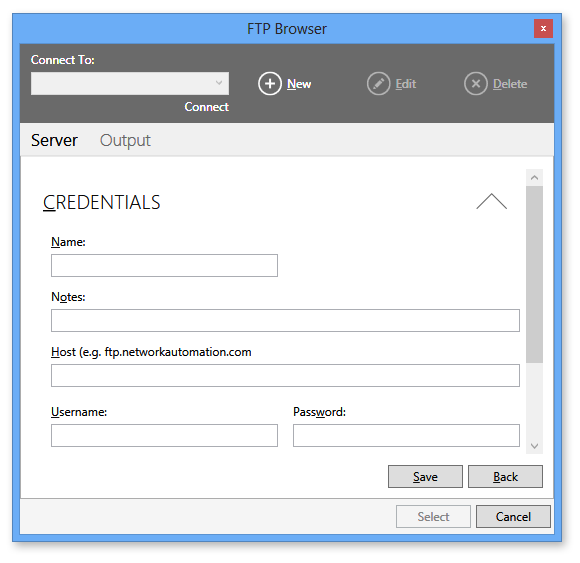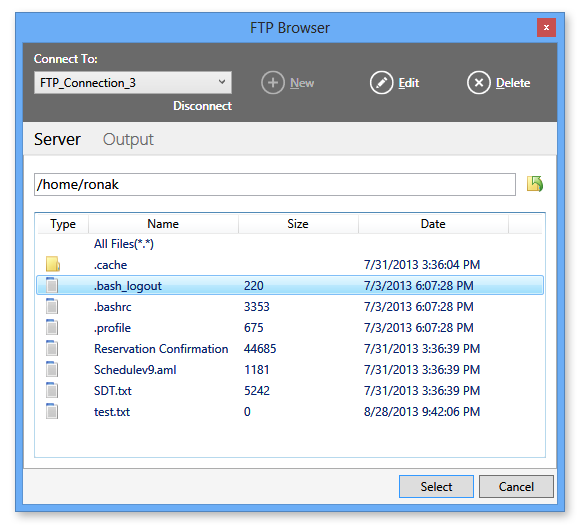FTP Browser
The FTP Browser is a convenient development tool that comes packaged with the FTP action. It is an easy to use graphical interface that enables connection to the target FTP server to browse remote directories and view or select remote files during task construction. The browser contains two views separated by tabs. The Server view lets you create and configure multiple connections which are automatically stored so you can quickly re-connect to the FTP site of your choice by simply selecting from a list of pre-configured connections. During connection, the Output view displays real-time data about the transaction between and the FTP server, which can be useful in diagnosing obscure connection problems or identifying errors. In addition, the browser uses its own session, therefore, you can always browse the server even during FTP transfers.
The FTP browser can be accessed in the properties of any FTP activity that performs actions on remote folders and/or files (e.g., FTP - Upload, FTP - Download and FTP - Rename). These activities contain a Remote Folder or Remote File property allowing specification of a remote folder/file in which to automate. A folder icon appears on the right-hand side of these properties, which, when clicked, opens the FTP Browser.
Using the FTP Browser
The FTP browser is a tool generally used during task development to provide a way for you to view folders and files that reside in the FTP server or select a file that a specific FTP activity should perform operations on during task execution. to view remote files, you must first establish a connection to the FTP server. Upon opening the FTP browser,
To create a new connection:
-
Click the New button. A connection editor appears where you can configure your new connection.
-
In the Credentials properties, enter a unique name for the connection in the Name field.
-
In the Notes box, enter any notes you wish to convey about the connection.
-
In the Host box, enter the IP address (xxx.xxx.xxx.xxx) or the server and domain name (server.domain.com) for the FTP host.
-
Enter the user name and password for the logon or select Use anonymous logon if the server is configured to accept anonymous logons.
-
In the Advanced properties Connection Type parameter, select the appropriate type of connection.
-
Enter other properties (if needed).
-
Click Save to save the connection. The name you entered for this connection will appear in the Connect To drop-down.

To edit/remove an existing connection:
-
Click the down arrow under the Connect To parameter to display a list of existing connections.
-
Select the connection you wish to edit or delete.
-
Click the Edit button to edit the properties of the connection or click the Delete button to permanently delete it.
To browse remote folders or select remote files:
-
Select the desired connection from the Connect To drop-down list and click Connect.
-
After a successful connection attempt, the FTP browser displays a list of files and folders on the main window and the current folder is listed in the edit field above the main window (as shown below).
-
To change folders, do one of the following:
-
Double-click the desired folder in the file list.
-
Enter the path and folder name into the edit field and press ENTER.
-
To navigate up one directory, click the back icon to the right of the edit field.
-
-
To select a file, navigate to the folder that contains the file you wish to select (as per above instructions) and do one of the following:
-
Double-click the file in the file list.
-
Select (highlight) the file in the file list and click the Select button.
-
